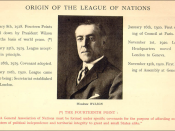In the 1920s, the League of Nations achieved some significant successes involving the international community. One of the main achievements was making agreements that were designed to solve international conflict and sustain global peace. The League managed to solve disputes over the Upper Silesia, Aaland Islands, Bulgaria, and other small nations. It also addressed the issues of health, transport, refugees, working conditions and other social problems around the world.
The League of Nations was successful in maintaining a temporary democratic structure in unstable areas, whilst organising a more permanent solution. This was seen in 1921 in the Upper Silesia (on the border between Germany and Poland) with people from both nationalities. The two countries both wanted control, and a vote was organized by the League. The population was divided, so the League partitioned areas and built safeguards to avoid possible arguments in the future. Rail links, water and power supplies were efficiently arranged, and the decision by the League was accepted by both sides.
In this case, it was a major success for the League as it managed to keep both sides peaceful, with the use of a democratic system appealing to the people.
In 1921, Sweden and Finland were both threatening to fight for control of the Aaland Island. Both appealed to the League, and the League's decision was to give the islands to Finland. This was accepted by Sweden, and war was avoided again.
In October 1925 Greek soldiers were killed on the border of Greece and Bulgaria. Greek troops invaded Bulgaria, and the League took action, ordering Greece to withdraw from Bulgaria and pay compensation. The Greeks obeyed.
The League created the Health committee, which combated epidemics of typhus, cholera, and dysentery. They also organised medical assistance and the distribution of vaccines. The Committee designed a...



League of Nations
You've written a good essay about the successes and failures of the League of Nations. With the United States not a member and lacking genuine enforcement ability, the League seemed destined to ultimately fail. Happily, the League's successor, the United Nations, has been a more effective organization although the UN has also frequently failed. When you have any internal citation, you should probably include a bibliography as well. Overall, great job!
5 out of 5 people found this comment useful.